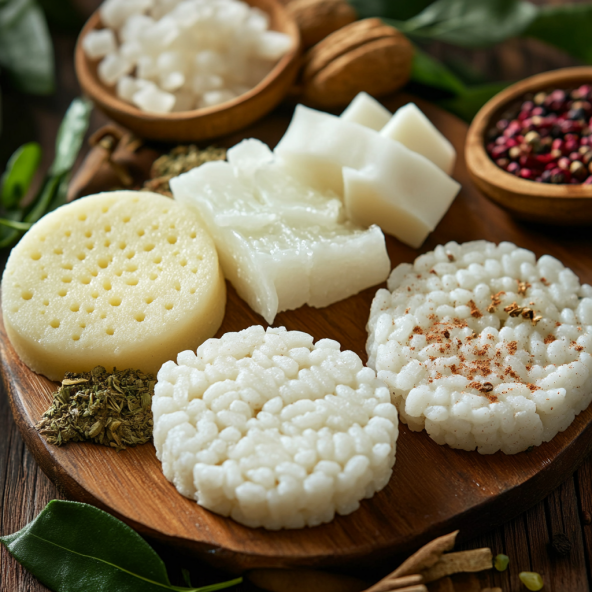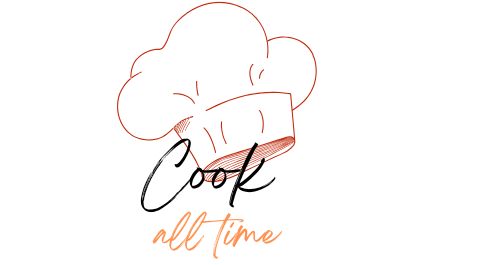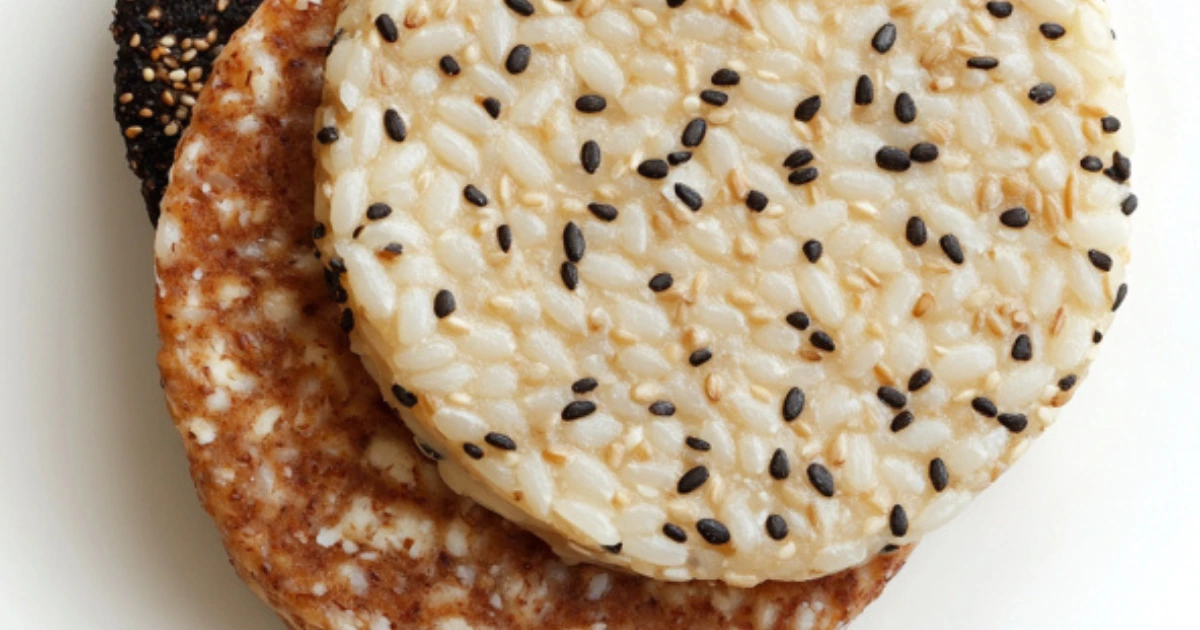Introduction: What is the Disadvantage of Rice Cake?
Rice cakes are crispy, lightweight snacks made from puffed rice. They are enjoyed worldwide for their simplicity and versatility. These snacks have gained popularity due to their low-calorie nature and ease of consumption. Rice cakes are often marketed as a healthy option. They are favored by individuals looking for a quick, portable snack or a base for various toppings. However, despite their popularity, it’s important to explore the disadvantages of rice cakes. This article answers the question, “What is the disadvantage of rice cake?” by analyzing the nutritional profile, glycemic index, and other factors that may affect your health
Table of Contents
Nutritional Profile of Rice Cakes: What is the Disadvantage of Rice Cake in Terms of Nutrients?
Rice cakes may appear healthy, but understanding their nutritional composition is crucial. They are often made from refined white rice, which has limited nutritional benefits. Rice cakes typically provide carbohydrates with little protein, fat, or fiber.
- Macronutrient composition: The primary component of rice cakes is carbohydrates. Depending on the type, they may contain small amounts of protein and minimal fat.
- Calories per serving: On average, rice cakes contain about 35 to 50 calories per serving, making them a low-calorie snack option.
- Variability in nutritional value: The nutritional content of rice cakes can vary, especially if they are flavored or made from different types of rice, such as brown rice or white rice.
Understanding what makes up rice cakes can help answer “What is the disadvantage of rice cake?” and highlight their limited nutrient density.
High Glycemic Index (GI) – What is the Disadvantage of Rice Cake for Blood Sugar?
Rice cakes have a high glycemic index (GI), which is a measure of how quickly foods raise blood sugar levels. Foods with a high GI can cause rapid spikes in blood sugar, leading to a quick energy boost followed by a crash. This can be particularly concerning for individuals with diabetes or those looking to manage their weight.
- Definition and impact of high GI foods: Foods with a high GI, like rice cakes, increase blood sugar levels quickly. This can cause fluctuations in energy and hunger.
- How rice cakes affect blood sugar levels: Eating rice cakes can result in a spike in blood sugar levels, followed by a rapid decline, which can lead to feelings of hunger soon after consumption.
- Managing GI effects: To mitigate the GI effects of rice cakes, consider pairing them with protein, fiber, or healthy fats, which can help slow down the absorption of sugar.
For those wondering “What is the disadvantage of rice cake?” Their high glycemic index (GI) is an important factor to keep in mind.
Low Nutrient Density: What is the Disadvantage of Rice Cake When It Comes to Micronutrients?
Rice cakes are low in essential vitamins and minerals, making them less nutrient-dense compared to other snacks. While they provide a quick source of energy, they fall short in offering a balanced nutritional profile. This limitation can affect long-term health if rice cakes are consumed regularly as a primary snack.
- Lack of essential vitamins and minerals: Rice cakes typically lack significant amounts of vitamins and minerals like vitamin C, calcium, and iron, which are important for overall health.
- Comparison with other snacks: Compared to whole-grain snacks or fruits, rice cakes are less nutrient-rich and provide fewer health benefits.
- Nutritional gaps to consider: Regular consumption of rice cakes without incorporating other nutrient-dense foods can lead to deficiencies in essential nutrients.
This limited nutritional value answers the question, “What is the disadvantage of rice cake?” Since they cannot supply all the essential nutrients the body requires.
Potential for Overeating: Why Do Rice Cakes Lead to Overconsumption?
One of the disadvantages of rice cakes is that they may not keep you full for long. Their low fiber and protein content contribute to low satiety levels, making it easier to overeat. People may consume multiple rice cakes in one sitting, thinking they are low-calorie, which can result in excess calorie intake.
- Low satiety levels: Rice cakes do not provide lasting fullness, which can lead to hunger and cravings shortly after eating.
- Role in hunger and cravings: Due to their high GI and lack of fiber, rice cakes may cause hunger to return quickly, leading to the temptation to eat more.
- Strategies to avoid overconsumption: Pairing rice cakes with protein-rich toppings, like nut butter or avocado, can help increase satiety and prevent overeating.
Thus, “What is the disadvantage of rice cake?” could also include its potential to cause overeating if consumed alone without additional nutrient-rich foods.
Not Suitable for All Diets: What is the Disadvantage of Rice Cake for Specialized Diets?
Rice cakes may not be suitable for certain diets, especially for individuals with specific health conditions. Their high glycemic index and lack of essential nutrients can make them less appropriate for people with diabetes or those following low-carb diets, like the ketogenic diet.
Issues for diabetic individuals: Rice cakes can cause rapid spikes in blood sugar levels. This is problematic for individuals with diabetes who need to manage their blood sugar levels carefully.
Challenges in weight management: Despite being low in calories, rice cakes might not be ideal for weight management. Their high glycemic index and the potential for overeating can counteract weight control efforts.
Compatibility with ketogenic diets: Since rice cakes are primarily made from carbohydrates, they don’t fit well with the low-carb, high-fat ketogenic diet.
This brings up the question: “What are the disadvantages of rice cakes?” It’s important to consider their limitations for certain diets and health conditions.
Flavor and Texture Limitations: What is the Disadvantage of Rice Cake for Taste and Enjoyment?
Rice cakes are often criticized for their bland taste and texture. On their own, they lack significant flavor. While toppings can enhance their taste, rice cakes are typically plain unless combined with seasonings, spreads, or other ingredients.
Blandness without toppings: Rice cakes are generally flavorless unless paired with seasonings or spreads, which can make them less appealing to some people.
Texture considerations: Their light, crunchy texture may not be suitable for everyone. Some people prefer denser, more flavorful snacks, which can make rice cakes less enjoyable.
Preference variability among consumers: While some people enjoy the simplicity and texture of rice cakes, others find them unappetizing.
This leads us to the question, “What is the disadvantage of rice cake?” The limitations in flavor and texture are important considerations for those choosing rice cakes as a snack.
Environmental Concerns
When considering rice cakes as part of a regular diet, it’s crucial to evaluate their environmental impact. Rice cultivation, while necessary for producing rice cakes, can have negative effects on the environment. Rice paddies require large amounts of water and can contribute to greenhouse gas emissions, particularly methane. In addition, the large-scale production of rice for commercial products adds to environmental concerns.
- Impact on water scarcity: In areas already facing droughts or water shortages, the high water demand of rice cultivation can worsen the crisis, affecting both agriculture and local communities
- Packaging waste from commercial rice cakes: Pre-packaged rice cakes often come in plastic wrappers, contributing to packaging waste. This can add to environmental pollution.
- Sustainability challenges: To make rice cakes more sustainable, companies need to explore alternative packaging and more eco-friendly farming methods.
Considering the environmental concerns surrounding rice cakes answers the question, “What is the disadvantage of rice cake?” from a broader perspective.Learn about the benefits of making rice cakes at home in What is Rice Cake Made Of?
Additives in Flavored Varieties
Flavored rice cakes, while convenient and often marketed as tasty snacks, may come with several health drawbacks due to added ingredients. These additives can significantly reduce their nutritional value, making them less healthy compared to plain rice cakes.
Hidden sugars and salts:
Many flavored rice cakes contain added sugars and excessive salt. These ingredients are used to enhance taste, but they can contribute to poor health when consumed in large amounts, potentially leading to weight gain and an increased risk of cardiovascular diseases.
Artificial flavors and preservatives:
To prolong shelf life and improve taste, some rice cakes include artificial flavorings and preservatives. These substances can introduce unwanted chemicals into your diet, which may have long-term effects on your health, such as allergic reactions or other sensitivities.
Health implications:
The high sugar and sodium content found in flavored rice cakes can increase the risk of chronic health conditions like hypertension, diabetes, and obesity. Thus, when asking “What is the disadvantage of rice cake?”, these health risks associated with flavored varieties should be carefully considered.
When evaluating “What is the disadvantage of rice cake?” flavored varieties often introduce hidden health risks that shouldn’t be ignored.
Comparison with Alternative Snacks
Rice cakes are often seen as a healthier snack alternative. However, it’s important to compare their nutritional value to other commonly consumed snacks, such as crackers, bread, and chips. While rice cakes are low in calories, they may lack some essential nutrients found in these other options. Additionally, crackers, bread, and chips often provide more fiber and protein, making them a more filling choice. In conclusion, while rice cakes are a light snack, they may not offer the same nutritional benefits as other alternatives.
- Nutritional comparison with crackers, bread, and other snacks: Rice cakes are typically lower in calories but are often higher in glycemic index, making them less ideal for steady energy. In comparison, whole grain crackers or bread provide more fiber and essential nutrients.
- Situations where alternatives may be better: In some cases, snacks like fruits, nuts, or whole grain bread may offer a better nutritional profile, providing more fiber, healthy fats, and protein.
This comparison shows that rice cakes are a convenient snack. However, they may not always be the best choice for overall nutrition and energy needs. This highlights the question, “What is the disadvantage of rice cake?
Rice Cakes and Fitness Diets
Rice cakes are a popular snack choice among athletes and bodybuilders due to their high carbohydrate content and quick digestibility. However, they come with both advantages and disadvantages when included in a fitness diet.

- Advantages for athletes: Rice cakes provide a quick source of carbohydrates, helping replenish glycogen stores after intense workouts. Their light texture makes them easy to digest without causing stomach discomfort.
- Drawbacks in recovery meals: While rice cakes are effective for glycogen replenishment, they lack essential protein and fats that are crucial for muscle recovery. Consuming them without a balanced meal could hinder recovery.
- Balancing rice cakes with other foods: To maximize their benefits in a fitness diet, it’s important to pair rice cakes with protein-rich toppings like peanut butter, cottage cheese, or yogurt.
Rice cakes can be a useful tool for athletes, but understanding “What is the disadvantage of rice cake?” is essential for incorporating them into a balanced fitness plan.
How to Mitigate the Disadvantages
To make rice cakes a more beneficial part of your diet, it’s essential to mitigate their disadvantages. Pairing them with nutrient-dense ingredients can help make them more balanced and filling.
- Pairing with nutrient-rich toppings: Add avocado, hummus, or lean proteins like turkey or chicken to your rice cakes to increase their nutritional value.
- Choosing whole-grain or organic rice cakes: Opt for whole-grain or organic varieties, as these can offer more fiber and micronutrients compared to conventional rice cakes made with refined rice.
- Mindful portion control: Rice cakes can be easily overconsumed due to their low satiety levels. Practice portion control and combine rice cakes with other foods to avoid overeating.
These strategies help address “What is the disadvantage of rice cake?” by enhancing their nutritional profile and overall health benefits.
Consumer Opinions on Rice Cakes
While rice cakes are popular, consumer feedback reveals mixed opinions regarding their taste, usability, and versatility in the kitchen.
- Common feedback on taste and usability: Many consumers find rice cakes bland on their own and prefer to add toppings to enhance flavor. Others appreciate their simplicity and convenience.
- Popular toppings and combinations: Some popular toppings for rice cakes include almond butter, honey, banana slices, or turkey. These additions can make rice cakes more flavorful and nutritious.
- Tips from experienced users: Experienced rice cake consumers suggest using them as a base for a variety of toppings, depending on the desired flavor profile. They also recommend experimenting with savory options like avocado or eggs for a more balanced snack.
Consumers’ feedback provides valuable insights into the disadvantages of rice cakes and suggests ways to improve them.
FAQs About What is the Disadvantage of Rice Cake
Here are some common questions people ask about rice cakes:
Are rice cakes healthy?
Rice cakes can be part of a healthy diet if consumed in moderation and paired with other nutrient-dense foods.
Are rice cakes suitable for weight loss?
Yes, rice cakes are low in calories and can fit into a weight loss diet, but you should avoid overeating them due to their low satiety levels.
Can rice cakes be gluten-free?
Many rice cakes are naturally gluten-free, but always check the label to ensure there are no added gluten-containing ingredients.
How can I make rice cakes more filling?
Add protein-rich toppings like nut butters, cheese, or chicken to increase satiety.
Conclusion
In conclusion, rice cakes are a versatile and convenient snack that can be part of a balanced diet. However, it’s important to consider their disadvantages, including their high glycemic index, low nutrient density, and potential for overeating. By pairing rice cakes with nutritious toppings, choosing whole-grain varieties, and practicing portion control, you can make them a healthier choice. While rice cakes may have some drawbacks, they can still fit into a well-rounded diet when consumed wisely.

